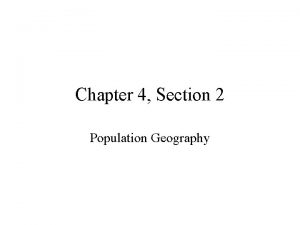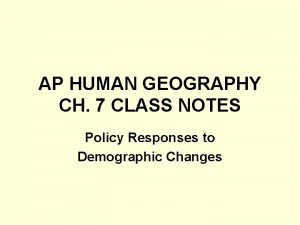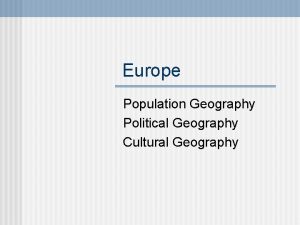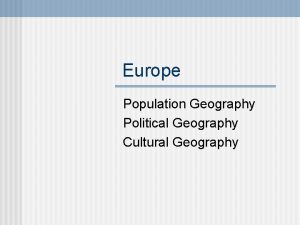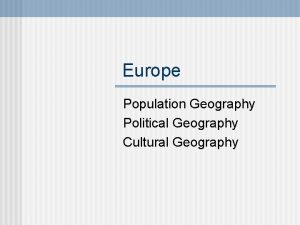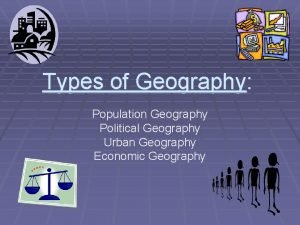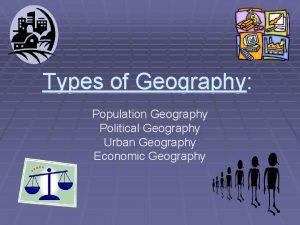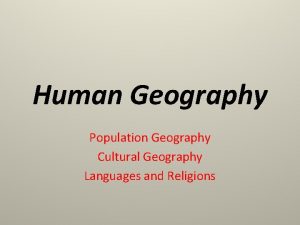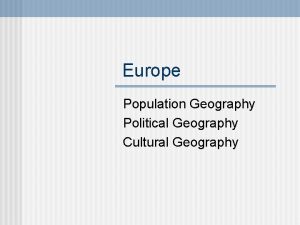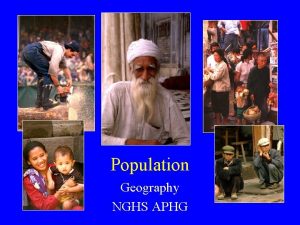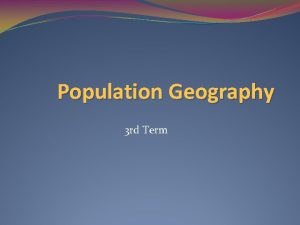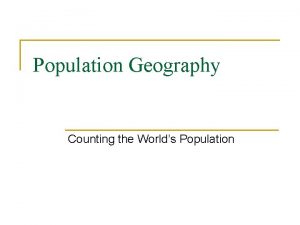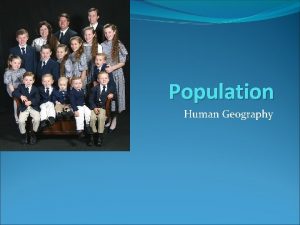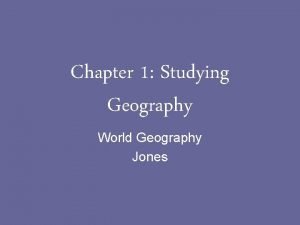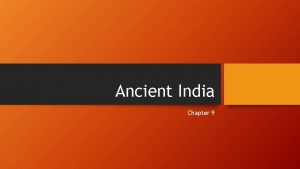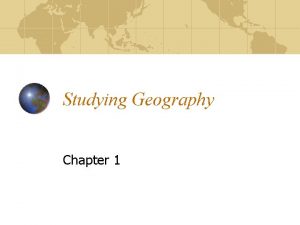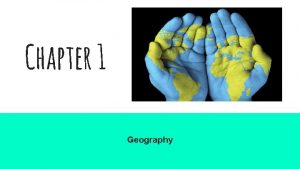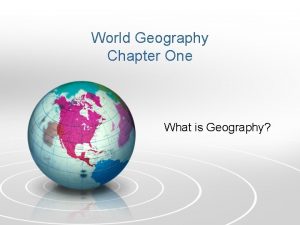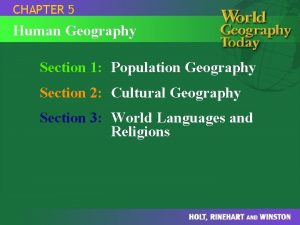Chapter 9 The Geography of Population The population

































- Slides: 33

Chapter 9: The Geography of Population The population is composed of different categories of gender, age, race, ethnicity and other factors of social difference. The social construction and spatial distribution of these categories reveals how social and cultural geographies are created and maintained. Expanded by Joe Naumann UMSL Women in Medan, Indonesia.

Chapter Learning Objectives • Identify the current population of the world, and describe its distribution and associated attributes. • Consider the power and meaning ascribed to national populations within countries and between countries. • Recognize the social categories by which populations differ and reflect the experience of difference within a population. • Explain the forms and reasons for movement of populations in a variety of scales and contexts. • Identify and evaluate the different models of population movement.

World Population • Close to 7. 5 billion • Distribution – Landmass – Northern mid-latitudes concentration – Reflects our historical reliance on agriculture – Currently population concentrated in industrial areas Global distribution of population (courtesy of Bill Rankin, www. radicalcartography. net).

Basic Distribution of World Population More than 50% of the world population is considered to be living in urban areas Global distribution of population (courtesy of Bill Rankin, www. radicalcartography. net).

The Distribution of Population • Variant of Tobler’s Law: who you are depends on where you are – International differences – Population and power • Advantages and disadvantages – Large countries have greater weight, but less national coherence – Small countries have homogeneity, but are more vulnerable Population distribution by country.

The Distribution of Population • National imaginaries – Refer to spatial nature and representation of the nation state • Difference in demographic reality and political representation – US Senate and House – Other countries Population map of USA shows its metropolitan nature.

Table 9. 1 Population and Political Representation in the US Senate Shows the disparity between the top most populous states. The House of Representatives is apportioned on the basis of population

National Populations • Demographic Cumulative Causation – Redistribution of people to areas of greater economic opportunity – Reinforces differences between receiving and sending regions • Governments address regional differences through policy – Should work better in federal republics

Immigrant National Populations Demographic Cumulative Causation Emigrant

Population Differences • “Population” is an aggregate term that covers different types of people – Many sources of difference, some biological vs. social • Social difference – Product of social relations that are coded, reinforced, policed – Subject to change • Three major sources – Gender – Age – Race/ethnicity (ability of minority cultures to assimilate varies)

Population Differences GENDER • Gendering of space and place – Gender occupies space differently – Gender distinctions and cultural identity • Gender roles in the economy highly influenced by culture – Vary across public and private spheres – Vary over time – some cultures accept change more easily than others Rosie the Riveter, an image of female muscular power, was used to recruit women.

Population Differences GENDER • Women in economy – Female participation rates higher in peasant and service economies – Double bind of work in formal and domestic economies – Patriarchal societies and the male gaze – Machismo • Women as chattel • Submissive role for women • Women as equal individuals (resisted in patriarchal societies) • Gendered relations intersect with other relations of power

Population Differences

Population Differences AGE • Life cycle stages vary across space and time – Historically (agrarian) children seen as labor (economic asset), today (urban/industrial) as receptacles of formal education (economic liability) – Social acceptability of age of childrearing varies around the world • Each society has different religious beliefs (influences attitudes, world view, and objectives) and levels of modernity (technical skills) – Impacts meaning and attitude toward life stages


RACE/ETHNICITY Population Differences • Social constructions are result of socioeconomic, not biological processes – Races are identified in relation to other races – really not very useful – Racialized groups refers to social construction in order to classify and control – REALITY: all are members of homo sapiens – one species – one race • Ethnicity refers to different collective identities (different cultures) – Imposed ethnicity is a group named and treated as ethnically different – Adopted or symbolic ethnicity is an individual’s choice to express an ethnic identity

Population Differences RACE/ETHNICITY • Racial/ethnic clustering – Support systems and platforms to new society – Degree of clustering is a function of degree of difference between group and dominant population – May also result from discrimination • Created and maintained by acts of power – Evolution of Chinatown in Vancouver, BC is a result of institutional power • Melting pot gives way to different forms of polyculturalism as various groups interact and change one another

The Movement of Population • People always on the move • Daily Space-Time Paths – Daily rituals constrained by time and access • Seasonal Movements – Transhumance of mountain herds move from summer to winter pasture – Rural to urban migration can be permanent or seasonally circular – Ritual of vacation for the affluent Traces the path of two people who leave their homes to go to work, then meet up in a café.

Migration (it takes a lot to overcome inertia) • Push factors (what’s wrong with • Pull factors (what seems better where you arf? somewhere else) – Famine – War – Lack of job opportunities – Repressive social or political system – Persecution If the possibility of improvement seems real, it will take greater pull factors to overcome inertia. – Greater freedom – Greater economic opportunities – Greater social opportunities – More desirable climate

di. . The Age of Distraction • People occupy space while communicating with people and things in other places • Age of distraction – Dangers – Suboptimal multitasking • Rushkoff’s digiphrenia (digital schizophrenia: digiphrenia - the constant, insane dual personalities people are immersed in between their phones and the real life. . ) – Social media-created – Multiple places and more than one self all at one

The Age of Distraction Amend daily space-time paths to include virtual activities occurring in different places.

The Movement of Population • Metropolitan redistributions – Movement between and within metro areas – Suburbanization and recent shift back to the city (gentrification) • Rural to Urban – Largest permanent relocation in world of last 50 years – Pronounced in countries with rapid population growth, industrialization, and modernization – Remakes cultural identities and the study of immigrant cities by the Chicago School – An assimilationist model of change saw immigrants as the raw material in creation of a new urban society

Forced Migrations • Forced migrations occur when people are forced to move • Globally significant slave trade – Triangular trade pattern – Accumulated wealth in Europe and the Americas • Common causes today – War, political conflict, social unrest create both international refugees and internally displaced persons – Economic refugees The largest refugee camps in the world are in the Horn of Africa.

• Characteristics International Migration – Voluntary forms – Half are women – Temporary migrants and remittances (guest workers) – Permanent migrants and cultural change • Push-and-pull factors – Countries respond with varying immigration regimes • Brexit • European resistance to massive exodus of refugees from Syria

International Migration • Affects both origin and destination countries • Periods of increased globalization – US immigration history – not always welcoming to some – Substantial waves of international movement • Countries with very low foreign-born population – a prevalent attitude – Mixture of limits by opportunity or policy

International Migration

International Migration • Diverse experiences – Investors and flight capital – Construction migrants – Expatriate communities • Gateway cities – Large portions of foreign-born • Global cities are places of: – Minority, diasporic communities and hybrid identities Ethnic homogeneity in Seoul, South Korea.

Models of Population Movement RAVENSTEIN’S LAWS OF MIGRATION • Generalizations of a particular time and context 1. Most migrants move only a short distance, towards the nearest city. 2. Migration is stepped. Growing cities attract migrants from nearby rural areas, which then draw migrants from more distant areas. 3. Each current of migration produces a countercurrent. 4. Long-distance migrants tend to move to major cities. 5. Rural people have higher propensity to migrate than urban people. 6. Women have higher propensity than men to migrate within countries, and more men tend to move internationally. 7. Migration is driven in largest part by economic forces.

Models of Population Movement • Gravity models – Movement related to population size and distance between areas – Space-time is warped and full of intervening opportunities • Lee’s Push-Pull Model – Origin and destination areas have range of factors – Case of the Great Migration in the US – People’s strong affect to friends and relatives explains existence of chain migration Lee’s push-pull model refers to specific forces between origins and destinations.

The Zelinsky and Metz Models • Transition model for mobility – Technology’s impacts • Zelinsky Model – 3 phases of increasing residential mobility • Metz model – 4 eras start with hunter-gatherers and ends with “peak car” areas

Chapter Summary • Bulk of the world’s population is in the Northern Hemisphere, centered on the Tropic of Cancer. It is distributed and demarcated in cultural, political, and economic space. • More than a third of the world’s population lives in just 2 countries, China and India. Half live in just 6 countries. The 10 largest countries contain almost 58 percent of world population. • Population size is an important element of national power. Very small countries tend to wield less power than larger countries. • Population distribution often connects with national imaginaries. • There are disparities between population distribution and political representation in a number of countries across the globe, including in the major global powers of Japan and the US.

Chapter Summary • As cumulative causation, movement of people to areas of greater economic opportunity can widen regional disparities. • Gender roles in an economy vary over time and space, partly influenced by rarely stable and unfixed gender identities. • Although there are definitive biological definitions for various ages, what it means to be at different stages in life varies across the world and throughout history. • Race and ethnicity are neither natural categories nor are they unchanging. The very definitions of race and ethnicity are social constructions, not biological processes.

Chapter Summary • Population movement takes place on daily, weekly, seasonal, and annual basis in circular and noncircular patterns, sometimes involving permanent relocations. Sometimes people are forced to move, as was the case in the slave trade. Today political conflict and lack of economic opportunities drive forced movement. • International migration channels are often routed very largely, although not exclusively, through major metropolitan areas known as gateway cities. Examples include New York, Amsterdam, Dublin, Washington DC, and Riyadh. • There are numerous models of population movement: Ravenstein’s model; the gravity models that focus on size and distance between places; and Lee’s push-pull model, which focuses on a comparative assessment between locations.
 Population ecology section 1 population dynamics answer key
Population ecology section 1 population dynamics answer key Chapter 4 section 1: population dynamics
Chapter 4 section 1: population dynamics Chapter 4 section 2 population geography
Chapter 4 section 2 population geography Population ecology section 1 population dynamics answer key
Population ecology section 1 population dynamics answer key Population ecology section 1 population dynamics
Population ecology section 1 population dynamics Eugenic population policies ap human geography
Eugenic population policies ap human geography Ap human geography frq format
Ap human geography frq format 5 themes of geography ap human geography
5 themes of geography ap human geography Ap human geography political geography test
Ap human geography political geography test Hát kết hợp bộ gõ cơ thể
Hát kết hợp bộ gõ cơ thể Bổ thể
Bổ thể Tỉ lệ cơ thể trẻ em
Tỉ lệ cơ thể trẻ em Voi kéo gỗ như thế nào
Voi kéo gỗ như thế nào Thang điểm glasgow
Thang điểm glasgow Chúa yêu trần thế
Chúa yêu trần thế Kể tên các môn thể thao
Kể tên các môn thể thao Thế nào là hệ số cao nhất
Thế nào là hệ số cao nhất Các châu lục và đại dương trên thế giới
Các châu lục và đại dương trên thế giới Cong thức tính động năng
Cong thức tính động năng Trời xanh đây là của chúng ta thể thơ
Trời xanh đây là của chúng ta thể thơ Mật thư tọa độ 5x5
Mật thư tọa độ 5x5 101012 bằng
101012 bằng Phản ứng thế ankan
Phản ứng thế ankan Các châu lục và đại dương trên thế giới
Các châu lục và đại dương trên thế giới Thơ thất ngôn tứ tuyệt đường luật
Thơ thất ngôn tứ tuyệt đường luật Quá trình desamine hóa có thể tạo ra
Quá trình desamine hóa có thể tạo ra Một số thể thơ truyền thống
Một số thể thơ truyền thống Bàn tay mà dây bẩn
Bàn tay mà dây bẩn Vẽ hình chiếu vuông góc của vật thể sau
Vẽ hình chiếu vuông góc của vật thể sau Biện pháp chống mỏi cơ
Biện pháp chống mỏi cơ đặc điểm cơ thể của người tối cổ
đặc điểm cơ thể của người tối cổ Thế nào là giọng cùng tên? *
Thế nào là giọng cùng tên? * Vẽ hình chiếu đứng bằng cạnh của vật thể
Vẽ hình chiếu đứng bằng cạnh của vật thể


